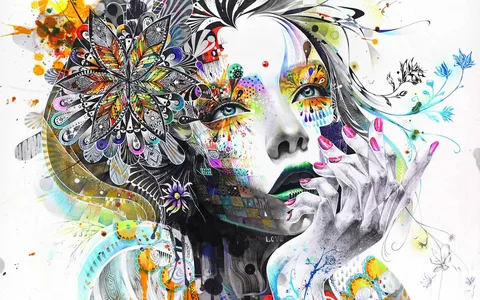AI Uses to Create Art, Music, Literature, and Design. Artificial Intelligence (AI) has become a transformative force in various industries, with its impact increasingly evident in the realm of creativity. AI’s involvement in art, music, literature, and design is not just a futuristic notion but a current reality that is reshaping how we produce and experience creative works. This article explores how AI is being utilized across these domains and discusses the implications for artists and intellectual property.
Overview of AI Technologies
AI encompasses a range of technologies that simulate human intelligence, including machine learning, neural networks, and natural language processing. In creative fields, these technologies enable machines to generate content, mimic artistic styles, and even produce entirely new forms of creative work.

Machine Learning (ML)
A subset of AI where algorithms learn from data to make predictions or decisions without being explicitly programmed.
Neural Networks
A series of algorithms modeled after the human brain, used to recognize patterns and generate outputs based on input data.
Natural Language Processing (NLP)
A technology that allows machines to understand, interpret, and generate human language.
Historical Context of AI in Creativity
AI’s journey into creativity began in the mid-20th century with early experiments in algorithmic art and music. Pioneering projects like Harold Cohen’s AARON, developed in the 1970s, laid the groundwork for modern AI art. Over the decades, advancements in computational power and algorithms have expanded AI’s creative capabilities, leading to today’s sophisticated applications in art, music, literature, and design.
The Evolution of AI Art
AI art has evolved from simple algorithmic patterns to complex creations that challenge traditional notions of art. Early AI art was primarily abstract, focusing on geometric patterns and color schemes.
High-Profile AI Art Exhibitions
AI-generated art has made a significant impact on the art world, with exhibitions at major galleries and museums. One notable event was the sale of “Edmond de Belamy,” an AI-generated portrait, at Christie’s auction house for $432,500. This sale marked a pivotal moment in recognizing AI as a legitimate artist in the contemporary art scene.

Early AI Art Projects
One of the earliest examples of AI in art is Harold Cohen’s AARON. AARON could create original drawings and paintings, laying the foundation for future AI art endeavours.
Modern AI Art Techniques
Today’s AI art utilizes Generative Adversarial Networks (GANs) and other advanced neural network models. GANs work by having two neural networks—the generator and the discriminator—compete against each other. This process results in art blending existing styles or creating entirely new visual forms.
Collaboration between AI and Human Artists
Musicians use AI tools to enhance their creative processes, generate new ideas, and explore innovative sounds. This collaboration allows artists to focus on the emotional and interpretative aspects of their work while AI handles technical and repetitive tasks.

AI and Graphic Design
AI’s impact on graphic design includes automating tasks, generating layouts, and creating brand identities. Designers use AI tools to streamline their workflows and explore new creative possibilities.
Case Studies of AI-Generated Art
Refik Anadol’s immersive installations are a prime example of how AI can create dynamic art. His works use data-driven algorithms to generate visuals that change in response to real-time inputs. These installations blur the lines between art and technology, offering viewers a unique and interactive experience.
Algorithms and Music Theory
They analyze patterns in chord progressions, scales, and rhythms to generate music that is theoretically sound and stylistically coherent. This capability allows AI to produce music that ranges from classical symphonies to contemporary pop hits.

Challenges and Opportunities in Music
The rise of AI in music presents challenges, such as potential job displacement and changes in how music is valued. However, it also offers opportunities for expanding creative possibilities and democratizing access to music production tools. Musicians must navigate these changes to leverage AI effectively while maintaining their artistic integrity.
AI and the Written Word
AI’s involvement in literature includes generating stories, poems, and articles. Advanced language models like GPT-3 can produce coherent and contextually relevant text, enabling new forms of literary creation.
Tools for AI-Generated Stories
These models can produce diverse genres of writing, from science fiction to romance, demonstrating AI’s ability to handle complex narrative structures.

Generative Design Models
Generative design uses algorithms to create a range of design options based on specific parameters. This approach allows designers to explore multiple creative solutions quickly, resulting in innovative and functional outcomes.
Applications in Branding and Marketing
AI is increasingly used in branding and marketing to analyze market trends and customer preferences. AI tools can generate visual content that resonates with target audiences, enhancing branding efforts and marketing strategies.
Conclusion
AI’s influence on art, music, literature, and design is profound and multifaceted. While it offers exciting opportunities for innovation and creativity, it also presents challenges related to ownership, attribution, and legal rights. As AI continues to evolve, it will be crucial for artists, designers, and policymakers to navigate these issues thoughtfully to ensure a fair and equitable creative landscape.
FAQs
How does AI create art?
AI creates art using algorithms and neural networks that analyze existing art styles and generate new visual content.
Can AI compose music that sounds like a human?
Yes, AI can compose music that closely mimics human styles by analyzing patterns in existing music. AI systems use machine learning algorithms to generate melodies, harmonies, and rhythms that resemble human compositions.
What role does AI play in music composition?
AI plays a significant role in music composition by analyzing patterns in existing music to generate new compositions.
In what ways is AI used in design?
AI is used in design through tools that automate tasks, generate creative concepts, and optimize designs. In graphic design, AI can create layouts, colour schemes, and brand identities. In product design, AI can explore multiple design options quickly and enhance functionality.
Can AI write literature, and if so, how?
Yes, AI can write literature by using advanced language models such as GPT-3.

